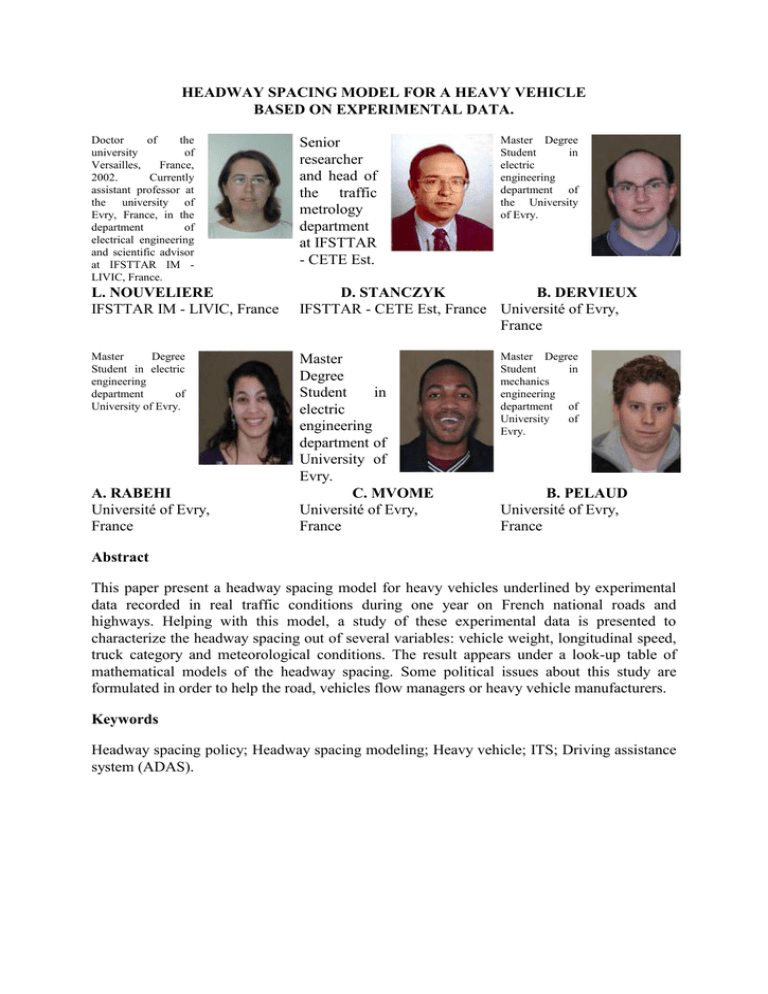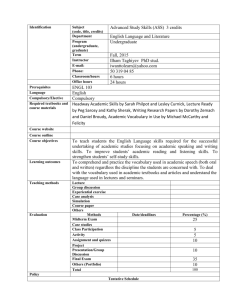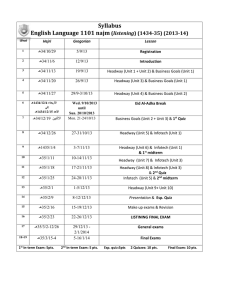HEADWAY SPACING MODEL FOR A HEAVY VEHICLE BASED ON EXPERIMENTAL DATA. Senior
advertisement

HEADWAY SPACING MODEL FOR A HEAVY VEHICLE BASED ON EXPERIMENTAL DATA. Doctor of the university of Versailles, France, 2002. Currently assistant professor at the university of Evry, France, in the department of electrical engineering and scientific advisor at IFSTTAR IM LIVIC, France. Senior researcher and head of the traffic metrology department at IFSTTAR - CETE Est. L. NOUVELIERE IFSTTAR IM - LIVIC, France D. STANCZYK B. DERVIEUX IFSTTAR - CETE Est, France Université of Evry, France Master Degree Student in electric engineering department of University of Evry. Master Degree Student in electric engineering department of University of Evry. C. MVOME Université of Evry, France A. RABEHI Université of Evry, France Master Degree Student in electric engineering department of the University of Evry. Master Degree Student in mechanics engineering department of University of Evry. B. PELAUD Université of Evry, France Abstract This paper present a headway spacing model for heavy vehicles underlined by experimental data recorded in real traffic conditions during one year on French national roads and highways. Helping with this model, a study of these experimental data is presented to characterize the headway spacing out of several variables: vehicle weight, longitudinal speed, truck category and meteorological conditions. The result appears under a look-up table of mathematical models of the headway spacing. Some political issues about this study are formulated in order to help the road, vehicles flow managers or heavy vehicle manufacturers. Keywords Headway spacing policy; Headway spacing modeling; Heavy vehicle; ITS; Driving assistance system (ADAS). 1. Introduction Nowadays many accidents imply a heavy vehicle that generates several injuries. Added to these serious consequences at the human level for the road users, these accidents generally induce some great traffic congestions, lead to some environment degradations or road infrastructure damages with some very high economic costs. As the heavy trucks traffic is going to increase by the ten years of 40% estimated, many developed countries are aware of that some political measures have to be urgently done, by proposing some efficient methods to detect certain abnormal scenarios, by generating some assistance system by advising or alerting the driver, the follower vehicles, the vehicles flow managers or the road managers. The ABV project (Low Speed Automation, financed by the French National Agency of research) consists of integrating several ADAS (Advanced Driving Assistance Systems) on various vehicles as light vehicles (cars, x-by-wire vehicles), heavy vehicles (city bus, heavy vehicles). The considered ADAS are safe longitudinal and/or lateral assistance systems, ecodriving advising systems. A safe itinerary is defined on which several services are offered to the automated vehicles, as safety and traffic information, but no communication is considered between the vehicles. A digital map can be used on-board to define an electronic horizon. To answer to these observations, several data were registered thanks to some French SIREDO roadside stations located on different roads types (highways, national roads). Based on them, the idea is to develop a safe headway model for the heavy vehicles using only some proprioceptive sensors and an Infrastructure-Vehicle (I-V) communication. In that way, a road manager or a vehicle flow manager could be helped in advising or alerting the vehicles on their area of interest to prevent from potential accidents or risky traffic situations. The paper aims to compute a headway spacing model for the heavy trucks by observing and filtering the SIREDO experimental data, and by associating different variables: headway spacing versus speed, headway spacing versus truck weight or truck type,… The main interest here remains by the fact that the used sensors are not embedded on the trucks but are on the road side, hence the experimental data do not take into account the driver behavior. The results are shown under several simulation plots and could help the road or vehicle flow managers to limit the headway spacing or the speed under some observed traffic conditions. 2. ABV project There is today a deployment of driver assistance with progression to a disengagement of the driver for safety tasks (emergency braking, ESP ...) demanding a faster action. It can be seen on the other hand, at low speeds, yet many only hardware accidents without security implications but these crashes generate a lot of time wasted in congestion created upstream. On a theoretical level, we can also show that the perceptual technologies and control systems are very effective to prevent the creation or neutralization of wave braking (congestion intiation). They are also more effective in creating positive waves (restart of the flow). The project consists of: Realizing perception functions and integrated longitudinal and lateral control. Implementing an experimental device permitting the conception of a partial or total strategy of disengagement of the driver at low speed on a congested motorway. The test vehicle of the project [3] is equipped with a copilot system with three options: Longitudinal control only (the driver has in charge the lateral action) Longitudinal control with lateral alert when lane departure Integrated longitudinal and lateral control (on a safe itinerary, including non automated vehicles in the traffic flow) 3. Description of experimental data Figure 1 - Weighing equipment for heavy vehicle on the circulating road. Experimental data from French Ministry of the Ecology, the Energy, the Sustainable Development and the Sea (IFSTTAR - CETE EST technical team) are registered. The French road networking is partially equipped with different measurement stations (SIREDO, STAL, EPM, …) at some key points to obtain a reality of the traffic on national roads and highways. In this paper, we will use the EPM situated in Loisy, FR (weighing equipment for heavy vehicle on the circulating road (Figure 1). The traffic on this road is characterized by a mean daily 17224 vehicles, among them a mean of 3703 heavy trucks (21.5% of the traffic). These road side units provide different signals during one year, namely: speed, position, acceleration, average speed of the traffic flow, circulating lane number, weight of the axle shafts, total weight, truck length, truck width, truck category, overweight, lateral position on the lane, date and time. About the road infrastructure, the truck occupation rate and the road type are also indicated. 4. Calculation of the safety distance The main purpose of this paper concerns the calculation of the safe headway spacing for a heavy vehicle. We thus now focus on relating the individual behavior of a given driver to the safety requirements associated with traffic conditions. This is achieved using a simple model of vehicle and the definition of the braking distance associated with a given vehicle and a given situation (weather conditions, braking capacity of the followed vehicle,...). Firstly, an expression of the braking distance is obtained then a parametrization of the braking distance is given and compared with recorded spacing in the traffic flow. 4.1 Vehicle modeling A nonlinear dynamic model of heavy vehicle is used, the brake and engine torques are given by a first order ODEs. Table 1 - Nomenclature for heavy vehicle parameters. Nomenclature M x(t) Kr I imax cx Tbr T*br br Te T*ac e e Ie R1,...,R4 h Fr Parameter description Vehicle mass Position of the vehicle Longitudinal tire stiffness Longitudinal slip Maximal longitudinal slip in the linear field Drag coefficient Brake torque Desired brake torque Time constant of the brake actuator Engine torque Desired engine torque Time constant of the accelerator actuator Engine speed Engine effective inertia Gear ratios Height of the center of the wheel Rolling resistance The longitudinal slip i at the contact between the tire and the road is taken into account leading, with the notations explained in the following nomenclature, to the following set of equations Mx(t ) K r .sat( I e e (t ) (1 i imax ) c x x (t ) 2 )Te (t ) R( hK r .sat( Tbr Tbr* Tac Tac* i imax 0 ) Tbr (t ) hFr ) Tbr br Tac ac with Tbr* (t ) 0 and Tac* (t ) 0 . When Rh (1) e (t ) x (t ) imax , the slip between the tire and the ground is given by i Rh e (t ) x (t ) max(Rh e (t ), x (t )) and the function sat(.) defined as follows (2) 1 i sat(i, imax ) i imax i [ imax , imax ] imax 1 i imax (3) is such that the traction force applied by the tires onto the road can be expressed by Ft K r sat(i, imax ) . A simplified model of the gearbox has been introduced in the vehicle model, speed limits that induce gear ratio modifications are defined and we assume that the transitions between two different gear ratios are linear and take around 0.5 seconds. One should notice that the second equation of (1) gives the engine speed e (t ) but it is expressed at the exit of the gearbox and not at the exit of the engine. Thus it is possible to have * ac vehicle stalls and the declutching is modeled by T (t ) 0 when e (t ) e (t ) 0 without the lim e . 4.2 Computation of the braking distance For a given vehicle and a given road surface, the braking distance could be defined as follows: assuming that at time t0, the vehicle brakes with a desired brake torque Tbr* (t ) , the braking distance performed by the vehicle before it stops. Obviously, this distance depends on the mechanical characteristics of the road-vehicle interaction system. Let consider at time t0 , the initial conditions are Tbr (t0 ) 0 Tac (t0 ) 0 x(t0 ) x0 x (t0 ) V0 e (t0 ) V0 (1 i0 ) Rh (4) where i0 denotes the slip I at time t0, the conditions Tac (t0 ) Tbr (t0 ) 0 considered hereafter are rather unrealistic and will be modified later. Since the vehicle decelerates only because of aerodynamic drag forces, one can assume 0 i0 0 . We look for ts such that x (t0 ts ) 0 leading to the definition of the braking distance ds d s (V0 , Tbr* , K r ,...) x(t0 ts ) x0 In this section, we consider that the slip I satisfies eq. (1) could be written under the form Mx(t ) K r ( Rh Tbr (t ) (t ) x (t ) ) ca x 2 (t ) imax x (t ) Tbr* (t ) Tbr (t ) e (5) imax i 0 and for t t0 , Tac* (t ) 0 so that 0 br I e e (t ) R ( hKr ( Rh x (t ) e (t ) ) Tbr (t ) hFf ) imax x (t ) and the time integration of (6) leads to (6) ds Ie 2 2 Rh M [ Ie Tbr* br2 h caimax Kr imax R 2h 2 Tbr* ts2 Tbr* br ts MV02 V0ts ( MV0ts 2Kr Ie 2h h ts 2 F f ts c R 2 h 2 t0 t s t 2 1 e br ) a x (u )dudt t0 t0 2 Ie t0 t s t0 x 3 (t )dt]. (7) A theoretical demonstration leads to the following expression of the safe distance ds tsmax ds 1 * br T hFf d min V0 t I eV0 hc V / 3 R 2h 2 a 0 Ie 2 2 Rh M ( hMV0 Tbr* br ) * max 2 imax R 2h 2 Tbr (t s ) Tbr* br 2 max [ MV0 V0t s ( ( br tsmax ) I e 2Kr Ie 2h h F f (tsmax )2 c R 2h 2 2 max 2 caimax 3 max ) MV0tsmax ) a V0 (t s ) V0 t s ]. 2 3I e 4Kr (11) Numerical values of the parameters are R=0.324, h=0.31m, imax=0.15, M=1500kg, Kr=12000kg.m.s-2, ca=0.4298kg/m, Ie=0.1454kg.m2, dmin=5m, t=0.2s, Ff=45.138kg.m.s-2, e,lim=900tr/min and br=0.072s. A simulation of the ds will be shown in the final version of the paper. With respect to initial speed V0 the results show that there exists suitable 2 coefficients a0, b0 and c0 such that d s a 0 b0V0 c 0V0 (t ) . Then at each instant t, the braking distance ds could be given, with a good accuracy, by d s ( x , t ) a 0 b0 x (t ) c0 x 2 (t ). 5. Braking distance and headway spacing comparison In this section, it is demonstrated that the braking distance can be expressed by ~ d s ( x (t ), t ) a 0 b0 x (t ) (c0 1 ). x 2 (t ) 2 a bx (t ) cx 2 (t ) (12) This analysis shows that the braking distance, and to within about a supplementary stopping distance dstop, the headway spacing can be expressed under a second order polynomial function. 6. Measurement of the headway spacing This section uses the SIREDO measured signals to estimate the value of the parameters a, b, c of the model (12). 6.1 Headway versus speed Headway spacing (m) 150 100 50 0 60 70 80 90 100 110 Speed (km/h) Figure 2 - Headway spacing versus speed with filtered data to distances less than 150m. The figure 2 shows the headway spacing of heavy trucks at the SIREDO station of Loisy in France during 6 months from June 2010 to November 2010. All the headway spacing up to 150m were eliminated because it means that there is no vehicle in front of the measured vehicle at the SIREDO station. Figure 2 does not permit to retain a given model because of the heterogeneity of the data. Headway spacing (m) 150 100 50 0 30 40 50 60 70 80 Speed (km/h) 90 100 110 120 (a) Headway spacing (m) 150 100 50 0 20 30 40 50 60 70 80 90 100 110 120 Speed (km/h) (b) Headway spacing (m) 150 100 50 0 -20 0 20 40 60 Speed (km/h) 80 100 120 140 (c) Figure 3 - Headway spacing versus speed (2010, France): (a) August, (b) June, (c) September. Figure 3 represents the same data but plotted by month (June, August, September 2010). One can detect a data cloud that has the same form in the three plots, namely a polynomial function of degree 2 which correspond to the model (12). We will then base our analysis on Figure 3. The non-linear least-square method is used to estimate the a, b, c parameters of the model (12) with a defined interval of confidence [DIV-, DIV+] in which the mean headway spacing is calculated. The results appear in Table 2. 6.2 Headway versus meteorological conditions Table 2 – Experimental results and parameters estimation. DIVPlace Weather Loisy Dry Loisy Wet Data samples 11905 24135 c b 0,552 0,0638 0,0405 0,0123 Interpolation DIV(m) for a given speed V V= a V= 20 m/s 25m/s 0,0048 22,87 36,08 0,001 26 40 Headway time at 90 km/h (s) 1,4432 1,6 Mean headway spacing DIVmean Place Weather Data samples Loisy Dry Loisy Wet 11905 24135 Interpolation DIV- (m) for a given speed V V= 20 V= c b a m/s 25m/s 0,0695 0,5037 0,00553 38,31 56,48 0,0912 0,026 0,0021 36,97 57,8 DIV+ Place Weather Data samples c Interpolation DIV- (m) for a given speed V V= 20 V= b a m/s 25m/s 0,0405 0,0048 48,49 72,87 Loisy Dry 11905 0,113 Loisy Wet 24135 0,1176 0,0692 0,0057 48,71 76,24 Headway time at 90 km/h (s) 2,2592 2,312 Headway time at 90 km/h (s) 2,9148 3,0496 Based on the table 2, between DIV- and DIVmean, the headway time is under the French safety law that imposes a headway time up to 2s. But in the [DIVmean, DIV+] interval, the headway time respects the 2s. The extension of the headway spacing with a wet weather is verified. 6.3 Headway versus vehicle weight Table 3 – Headway spacing model estimation versus truck weight. Interval of weight (in tons) Headway spacing model estimation [3 .5 ; 8.1] DIV(v) = 0,00820v² – 0,09380 v + 15,99890 [8.1 ; 15.2] DIV(v)= 0,00870v² + 0,00010 v + 4 [15.2 ; 22.1] DIV = 0,0093 v² + 0,0001 v + 3 [22.1 ; 28.6] DIV(v)= 0,0094 v² – 0,0183v – 2,9998 [28.6 ; 31.1] DIV(v) = 0,0098v² – 0,0070 v – 0,0001 The table 3 gives the headway spacing model estimation versus the heavy vehicle weight. The SIREDO stations permit to have a first mathematical model of the headway spacing for the heavy vehicles, taking into account the vehicle speed, the vehicle weight and the meteorological conditions. 7. Political issues about headway spacing characterization The results obtained from the SIREDO data do not provide a unique mathematical model of the headway spacing applied to the heavy trucks because of several factor influencing it as the vehicle speed, weight and meteorological conditions. But with these results, we are able to build a first map of headway models like a look-up table. This look-up table could be used by traffic managers as road or vehicles flow managers to provide a safe information to the drivers who circulate on a given managed area. This could be usefull for avoiding the traffic accidents due to an excessive speed, a bad weather in function of the weight of the vehicle. In given traffic conditions like congestions, the look-up table could also help the traffic managers in forbidding or not the heavy vehicles access to a given part of a highway for example. 8. Towards an eco-driving assistance system The ABV project aims at developing an EDAS (Eco-Driving Assistance System) for heavy trucks, while being safe on the road. The model (12) and its parameters estimation provides a good information to the system developed in [1,2] for the light vehicles or heavy trucks. Indeed, one can imagine that reducing the energy consumption cannot be an alone strategy without considering the safety issue. Thus the model (12) under a look-up table can be used to observe the headway spacing in the longitudinal direction to couple the safety aspect to the energy management. 9. Conclusion A detailed study of the longitudinal headway spacing of heavy vehicles is presented with experimental data recorded on real traffic conditions. A headway spacing model is formulated with accurate traffic/vehicle data and is used to express some goal statements, if any, destinated to road manager or vehicles flow managers. The resulted headway spacing model, experimentally estimated, can be provided to an EDAS under a look-up table of models depending on the longitudinal speed, vehicle weight and meteorological conditions. Acknowledgements The authors thank the French ANR VTT - ABV project (French National Agency of research - Low speed Automation project) for contributing to the realization of a part of this work. References [1] L.Nouvelière, H.T.Luu, F.R. Duval, B. Jacob, and S.Mammar, “Eco-driving assistance system for low fuel consumption of a heavy vehicle: advisor system”, HVTT11 International Heavy Vehicle Symposium 2010, Melbourne, Australia, 2010. [2] H.-T. Luu, L. Nouvelière, S. Mammar, “Towards a safer ecological driver assistance system”, ITS World Congress, Busan, Corea, Oct. 2010. [3] Project ANR VTT – ABV : www. http://pole-moveo.org/pdf-projets-das/ABV-F.pdf






